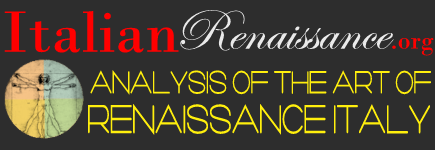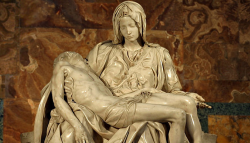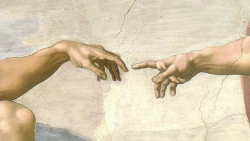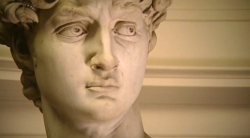Having finished, then, for the last, the said S. Francis, he returned to Florence, where, on arriving there, he painted, on a panel that was to be sent to Pisa, a S. Francis on the tremendous rock of La Vernia, with extraordinary diligence, seeing that, besides certain landscapes full of trees and cliffs, which was something new in those times, there are seen in the attitude of a S. Francis, who is kneeling and receiving the Stigmata with much readiness, a most ardent desire to receive them and infinite love towards Jesus Christ, who, being surrounded in the sky by seraphim, is granting them to him with an expression so vivid that anything better cannot be imagined. In the lower part of the same panel there are three very beautiful scenes of the life of the same Saint. This panel, which to-day is seen in S. Francesco in Pisa on a pillar beside the high-altar, and is held in great veneration as a memorial of so great a man, was the reason that the Pisans, having just finished the building of the Campo Santo after the design of Giovanni, son of Niccola Pisano, as has been said above, gave to Giotto the painting of part of the inner walls, to the end that, since this so great fabric was all incrusted on the outer side with marbles and with carvings made at very great cost, and roofed over with lead, and also full of sarcophagi and ancient tombs once belonging to the heathens and brought to Pisa from various parts of the world, even so it might be adorned within, on the walls, with the noblest painting. Having gone to Pisa, then, for this purpose, Giotto made in fresco, on the first part of a wall in that Campo Santo, six large stories of the most patient Job. And because he judiciously reflected that the marbles of that part of the building where he had to work were turned towards the sea, and that, all being saline marbles, they are ever damp by reason of the south-east winds and throw out a certain salt moisture, even as the bricks of Pisa do for the most part, and that therefore the colours and the paintings fade and corrode, he caused to be made over the whole surface where he wished to work in fresco, to the end that his work might be preserved as long as possible, a coating, or in truth an intonaco or incrustation—that is to say, with lime, gypsum, and powdered brick all mixed together; so suitably that the pictures which he afterwards made thereon have been preserved up to the present day. And they would be still better if the negligence of those who should have taken care of them had not allowed them to be much injured by the damp, because the fact that this was not provided for, as was easily possible, has been the reason that these pictures, having suffered from damp, have been spoilt in certain places, and the flesh-colours have been blackened, and the intonaco has peeled off; not to mention that the nature of gypsum, when it has been mixed with lime, is to corrode in time and to grow rotten, whence it arises that afterwards, perforce, it spoils the colours, although it appears at the beginning to take a good and firm hold. In these scenes, besides the portrait of Messer Farinata degli Uberti, there are many beautiful figures, and above all certain villagers, who, in carrying the grievous news to Job, could not be more full of feeling nor show better than they do the grief that they felt over the lost cattle and over the other misadventures. Likewise there is amazing grace in the figure of a man-servant who is standing with a fan beside Job, who is covered with ulcers and almost abandoned by all; and although he is well done in every part, he is marvellous in the[Pg 78] attitude that he strikes in chasing the flies from his leprous and stinking master with one hand, while with the other he is holding his nose in disgust, in order not to notice the stench. In like manner, the other figures in these scenes and the heads both of the males and of the women are very beautiful; and the draperies are wrought to such a degree of softness that it is no marvel if this work acquired for him so great fame, both in that city and abroad, that Pope Benedict IX of Treviso sent one of his courtiers into Tuscany to see what sort of man was Giotto, and of what kind his works, having designed to have some pictures made in S. Pietro. This courtier, coming in order to see Giotto and to hear what other masters there were in Florence excellent in painting and in mosaic, talked to many masters in Siena. Then, having received drawings from them, he came to Florence, and having gone into the shop of Giotto, who was working, declared to him the mind of the Pope and in what way it was proposed to make use of his labour, and at last asked him for some little drawing, to the end that he might send it to His Holiness. Giotto, who was most courteous, took a paper, and on that, with a brush dipped in red, holding his arm fast against his side in order to make a compass, with a turn of the hand he made a circle, so true in proportion and circumference that to behold it was a marvel. This done, he smiled and said to the courtier: “Here is your drawing.” He, thinking he was being derided, said: “Am I to have no other drawing but this?” “‘Tis enough and to spare,” answered Giotto. “Send it, together with the others, and you will see if it will be recognized.” The envoy, seeing that he could get nothing else, left him, very ill-satisfied and doubting that he had been fooled. All the same, sending to the Pope the other drawings and the names of those who had made them, he also sent that of Giotto, relating the method that he had followed in making his circle without moving his arm and without compasses. Wherefore the Pope and many courtiers that were versed in the arts recognized by this how much Giotto surpassed in excellence all the other painters of his time. This matter having afterwards spread abroad, there was born from it the proverb that is still wont to be said to men of gross wits: “Tu sei più tondo che l’ O di Giotto!” (“Thou art rounder than Giotto’s circle”). This proverb can be called beautiful not only from the occasion that gave it birth, but also for its significance, which consists in the double meaning; tondo being used, in Tuscany, both for the perfect shape of a circle and for slowness and grossness of understanding.
The aforesaid Pope then made him come to Rome, where, honouring him much and appreciating his talents, he made him paint five scenes from the life of Christ in the apse of S. Pietro, and the chief panel in the sacristy, which were all executed by him with so great diligence that there never issued from his hands any more finished work in distemper. Wherefore he well deserved that the Pope, holding himself to have been well served, should cause to be given to him six hundred ducats of gold, besides granting him so many favours that they were talked of throughout all Italy.
About this time—in order to withhold nothing worthy of remembrance in connection with art—there was in Rome one Oderigi d’Agobbio, who was much the friend of Giotto and an excellent illuminator for those days. This man, being summoned for this purpose by the Pope, illuminated many books for the library of the palace, which are now in great part eaten away by time. And in my book of ancient drawings are some remains from the very hand of this man, who in truth was an able man; although a much better master than Oderigi was Franco Bolognese, who wrought a number of works excellently in that manner for the same Pope and for the same library, about the same time, as can be seen in the said book, wherein I have designs by his hand both in painting and in illumination, and among them an eagle very well done, and a very beautiful lion that is tearing a tree. Of these two excellent illuminators Dante makes mention in the eleventh canto of the Purgatorio, where he is talking of the vainglorious, in these verses:
O, dissi a lui, non se’ tu Oderigi,
L’onor d’Agobbio, e l’onor di quell’arte
Che alluminare è chiamata in Parigi?
Frate, diss’egli, più ridon le carte
Che pennelleggia Franco Bolognese;
L’onor è tutto suo, e mio in parte.
The Pope, having seen these works, and the manner of Giotto pleasing him infinitely, ordered him to make scenes from the Old Testament and the New right round S. Pietro; wherefore, for a beginning, Giotto made in fresco the Angel that is over the organ, seven braccia high, and many other paintings, whereof part have been restored by others in our own days, and part, in founding the new walls, have been either destroyed or removed from the old edifice of S. Pietro, up to the space below the organ; such as a Madonna on a wall, which, to the end that it might not be thrown to the ground, was cut right out of the wall and made fast with beams and iron bars and thus removed, and afterwards built in, by reason of its beauty, in the place that pleased the pious love that is borne towards everything excellent in art by Messer Niccolò Acciaiuoli, doctor of Florence, who richly adorned this work of Giotto with stucco-work and also with modern paintings. By his hand, also, was the Navicella in mosaic that is over the three doors of the portico in the court of S. Pietro, which is truly marvellous and deservedly praised by all beautiful minds, because in it, besides the design, there is the grouping of the Apostles, who are travailing in diverse manners through the sea-tempest, while the winds are blowing into a sail, which has so high a relief that a real one would not have more; and moreover it is difficult to have to make with those pieces of glass a unity such as that which is seen in the lights and shadows of so great a sail, which could only be equalled by the brush with great difficulty and by making every possible effort; not to mention that in a fisherman, who is fishing from a rock with a line, there is seen an attitude of extreme patience proper to that art, and in his face the hope and the wish to make a catch. Under this work are three little arches in fresco, of which, since they are for the greater part spoilt, I will say no more. The praises universally given by craftsmen to this work are well deserved.
Giotto, having afterwards painted on a panel a large Crucifix coloured in distemper, for the Minerva, a church of the Preaching Friars, returned to his own country, having been abroad six years. But no long time after, by reason of the death of Pope Benedict IX, Clement V was created Pope in Perugia, and Giotto was forced to betake himself with[Pg 81] that Pope to the place where he brought his Court, to Avignon, in order to do certain works there; and having gone there, he made, not only in Avignon but in many other places in France, many very beautiful panels and pictures in fresco, which pleased the Pontiff and the whole Court infinitely. Wherefore, the work dispatched, the Pope dismissed him lovingly and with many gifts, and he returned home no less rich than honoured and famous; and among the rest he brought back the portrait of that Pope, which he gave afterwards to Taddeo Gaddi, his disciple. And this return of Giotto to Florence was in the year 1316. But it was not granted to him to stay long in Florence, because, being summoned to Padua by the agency of the Signori della Scala, he painted a very beautiful chapel in the Santo, a church built in those times. From there he went to Verona, where, for Messer Cane, he made certain pictures in his palace, and in particular the portrait of that lord; and a panel for the Friars of S. Francis. These works completed, in returning to Tuscany he was forced to stay in Ferrara, and he painted at the behest of those Signori d’Este, in their palace and in S. Agostino, some works that are still seen there to-day. Meanwhile, it coming to the ears of Dante, poet of Florence, that Giotto was in Ferrara, he so contrived that he brought him to Ravenna, where he was living in exile; and he caused him to make round the Church of S. Francesco, for the Signori da Polenta, some scenes in fresco that are passing good. Next, having gone from Ravenna to Urbino, there too he wrought some works. Then, chancing to pass through Arezzo, he could not but comply with the wish of Piero Saccone, who had been much his friend; wherefore he made for him in fresco, on a pillar in the principal chapel of the Vescovado, a S. Martin who has cut his cloak in half and is giving one part of it to a beggar, who is standing before him almost wholly naked. Then, having made for the Abbey of S. Fiore a large Crucifix painted in distemper on wood, which is to-day in the middle of that church, he returned finally to Florence, where, among many other works, he made some pictures in the Convent of the Nuns of Faenza, both in fresco and in distemper, that are not in existence to-day, by reason of the destruction of that convent. In the year 1322, likewise—Dante, very much his friend, having died in the year before, to his great sorrow—he went to Lucca, and at the request of Castruccio, then Lord of that city, his birthplace, he made a panel in S. Martino with a Christ in air and four Saints, Protectors of that city—namely, S. Peter, S. Regulus, S. Martin, and S. Paulinus—who appear to be recommending a Pope and an Emperor, who, according to what is believed by many, are Frederick of Bavaria and the Anti-Pope Nicholas V. Some, likewise, believe that Giotto designed the castle and fortress of Giusta, which is impregnable, at San Frediano, in the same city of Lucca.



